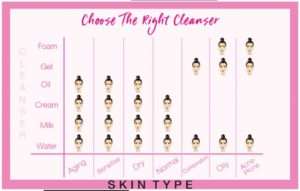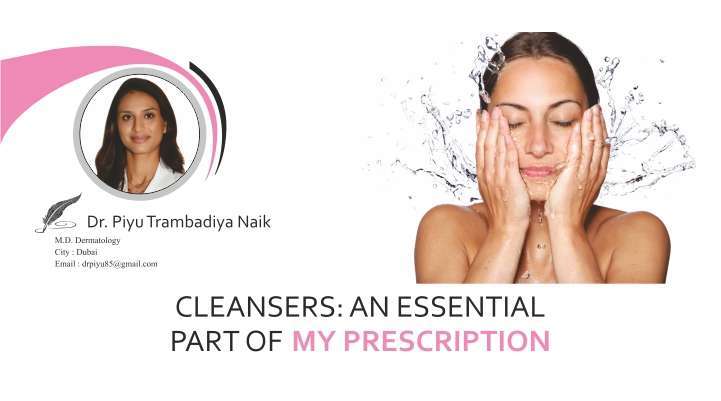There is one thing, without which my prescription is never complete. It’s clensers. Whether it is dermatological disease or cosmetic patient, I never forget to advise him/her regarding appropriate clensers or soaps according to their condition.
Why?
- Most important part of skin care routine.
- If not advised by dermatologist, patient will end up buying commercial product which may worsen the skin condition or reduces responsiveness of other dermatological treatments.
- Important part of post procedure advice in cosmetic patient to enhance effect of various cosmetic treatments and to prevent post procedural irritation.
- Different types of formulations are recommended for different types of skin.
The art of cleansing has progressed immensely over several thousand years from simply scraping the skin to an exercise in relaxation and improvement in the skin’s health and appearance in the present day. Soaps – the basic cleansing agent has also undergone a sea change in its evolution with many variants and newer constituents being incorporated into it.
The constituents of skin cleansers
- Water
- Surfactants (emulsifiers)
- Moisturizers (for hydration)
- Binders (stabilizers)
- Lather enhancers (in some)
- Fillers (hardeners)
- Preservatives (ingibit microorganisms)
- Fragrance (mask surfactant odour)
- Dyes or Pigments (in some)
Dermatological disorders in which cleansers may have a beneficial role
- Atopic dermatitis
- Acne
- Rosacea
- Photoages skin
- Occupational dermatitis
- Xerotic skin
- Sensitive skin
- Retinoid induced dermatitis and post peel
- Idiopathic Perianal Pruritus
Cleanser Composition
Surfactants are the principal constituents of most cleanser formulas and are mainly responsible for its cleansing action. The type and amount of surfactant in a cleansing agent has a bearing on its drying and irritancy potential.
Soaps
Soaps are composed of long chain fatty acid alkali salts with a pH of between 9 and 10.
Soap Subsets
Glycerin bars/transparent bars:
Used rampantly in our country in winter. They contain humectant–glycerine to counter the drying effects of soap.
Superfatted soaps:
Contain greater amount of lipids such as triglycerides, lanolin, paraffin, stearic acid, or mineral oils which provide a protective film on the skin.
Deodorant soaps/antibacterial soaps:
Contain antibacterial agents such as triclosan, triclocarban or carbanile to inhibit the growth of bacteria and thereby odor.
Harsh cleansers such as soaps are known to cause:
⦁ After wash tightness: it is a sensation of tightness perceived 5–10 min after washing with a soap. Rapid evaporation of water from the skin surface causes this tightness.
⦁ After wash tightness: it is a sensation of tightness perceived 5–10 min after washing with a soap. Rapid evaporation of water from the skin surface causes this tightness.
⦁ Skin dryness, scaling and roughness-lipid solvents such as acetone, alcohols and even nonionic surfactants can cause dryness of the skin. Cold weather and low humidity can aggravate these effects.
⦁ Skin irritation–skin irritation along with erythema and itching following the use of harsh soaps are mainly due to damage to the skin barrier.⦁ Allergic contact dermatitis to the fragrances, preservatives, or dyes present in some soaps.
Solution
Lipid free cleansing lotions
These contain fatty alcohols and are suitable for people with sensitive or dry skin. They can be wiped off without water. The fatty alcohols in these lotions facilitate evaporation and so rinsability is high. When used on the face, there is less facial residue which is an advantage of these lipid free-cleansing lotions. These agents also contain emollients (e.g., fatty alcohols) and/or humectants (e.g., propylene glycol) which counter the irritancy or drying potential of the surfactant.
Liquid body washes
These offer a different sensation, are more convenient as well as more hygienic than the wash bar. They employ milder surfactants and incorporate more emollients, thus can actually improve skin overtime.
Cold creams
They combine the effect of a lipid solvent, such as wax or mineral oil, with detergent action from borax.
Factors causing dryness and irritation in cleansers
The major factors affecting the drying and irritancy potential of cleansers include type and rinsability of surfactant ingredients and to a lesser degree pH.
– Surfactant ingredients:
Surfactants after binding to keratin cause protein denaturation, thus leading to damage to the cell membrane of keratinocytes. This in turn leads to adverse cutaneous responses. Surfactant chain length is also an important factor in determining the irritant potential with Kellum opining that the most noticeable irritant reactions developed with fatty acids having chain lengths from C8 to C12 coming in contact with the skin. Although anionic surfactants are considered to have the greatest irritancy potential, their proportion in a cleansing agent and their combination with cationic acrylate polymers or nonionic surfactants and humectants like propylene glycol modifies the irritation potential.
– Skin cleanser residue or rinsability factor:
The irritancy potential of a cleansing agent may increase the longer it is left on the skin. Residual levels of different products on the skin vary, and these levels correlate with irritation reactions.
– pH of cleansing agent:
Although controversial, but still many Dermatologists believe that maintaining the skin surface at its physiological pH (4–6.5) during cleansing prevents overgrowth of certain microorganisms, like Propionibacterium acnes. Soaps with an alkaline pH have also been said to cause damage to the lipid bilayer of the stratum corneum thus causing dryness of the skin. However, other workers have shown that the pH of a cleanser appears to have little effect on its role in damaging the skin. Present day synthetic detergents and lipid free cleansers have a neutral or slightly acidic pH which closely matches the skin pH.

MODERN FORMULAS AND CONCEPTS
Cleansing milks, lotions and creams
These are all oil and water emulsions, made to different consistencies depending on how thick a texture you are looking for. They are especially good at cleansing as the oil part removes the make-up, at the same time taking away as little of the natural oils from the skin as possible, while the water carries away the water-soluble waste.
Cleansing gels
Foaming gels that lather up contain detergents, as soap does, and can have the same effect, so are best suited to oilier skins. There are also gels that are suited to dry or sensitive skins and these should not lather up. Gels are often removed by just splashing with water.
Cleansing oil
Although there is not as vast an array of cleansing oils or cleansing balms on the market as other cleansing products, in my opinion they are the best thing to use. Also going under the name of Pre-Cleanser, these are an oil formula that you massage into the skin using fingertips, and then remove with (preferably) a face cloth. Oil formulas are more efficient at removing excess oil and grime from the skin, without stripping or drying it. Even if you have an oily skin, one of these cleansers is still going to remove sufficient grease!
Cleansers have evolved significantly from just serving as cleaning agents for removal of sebum, dirt, dead cells, and microorganisms from skin mainly because of the challenge of meeting the ever changing consumer expectations. With the advent of advanced technologies, newer cleansers are now being manufactured which are mild, provide moisturizing benefits and can be easily washed off. In various dermatological disorders, all these properties of modern cleansers enable them to be used concomitantly with topical therapeutic measures thus influencing the outcome of treatment and progression of the disorders. Dermatologists can enhance the overall management of various skin disorders by advising their patients how to adjust their cleansing regimen to best suit their needs and achieve optimal results with therapy.
Toner
A toner for oily skin will contain up to 70% alcohol and is astringent; it will be effective at removing the oils but cannot stop the skin from producing more – such oil production is down to your hormones and your diet. If you do use astringent products on oily skin to the extent that they remove the natural oils, your body will just produce more to make up for the deficiency, so by removing all the oil, you are not always doing your skin a favour. If you have not removed your cleanser properly, the toner is necessary to remove the last traces.
Micellar water
Micellar water is made of microscopic oil molecules that are suspended in purified water. These gentle oil molecules are called micelles. It is applied using a cotton pad or cloth and wiped over the skin to remove makeup, excess oil and build up. Tiny micelles form in the product and cling onto particles resting on the surface of your skin, wiping them off. It is suitable for both dry and combination/oily skin types, however if your skin is dry, you will need a rich moisturiser to follow this cleansing product.
*-*-*






